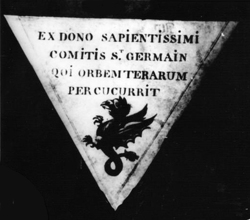Manly P. Hall Commentary
Manly P. Hall Commentary from SAGES & SEERS on Triangle Book
Saint-Germain taught that man has in him infinite possibilities and that from the practical point of view, he must strive unceasingly to free himself from matter in order to enter into communication with the world of higher intelligences.
This curious book was for many years in the Library of Lionel Hauser, Ancien membre du Conseil de Direction de la Societe Theosophique du France. It was sold with the rest of his collection at Sotheby's celbrated Auction House in London. He could give me no additional information about the manuscript which had come to him through the usual book collecting channels. He showed me at the time a Masonic Lodge coin which had belonged to a member of St.-Germain's group.
The book itself is triangular in shape, on vellum, and written in cipher with the exception of the title page. The cipher itself is quite simple, belonging to the class found in Masonic documents, and decodes into French. It is titled The Sacred Magic Revealed to Moses, recovered in an Egyptian monument and carefully preserved in Asia under the Device of a Winged Dragon...written about 1750. On the first page above a wyvern are the words: "By the gift of the most wise Comte de St.-Germain who passed through the circle of the earth." The writing itself belongs to a class known as Grimoire or Manuals of Ceremonial Magic. A free translation of the opening pages follows:
"The orbit (magic circle) which thou seest on the preceding page will serve thee as a model to make others which shall be nine cubits in diameter. Thou shalt use these to perform marvels, a priviledge which thy predecessors Beros and Sanchoniaton did not have. I give thee at the same time the intelligence of the characters in which is written my revelation so that thou mayest make use of them for three purposes: to find things lost in the seas since the upsetting of the globe (the Deluge); to discover mines of diamonds, gold and silver in the heart of the earth; to preserve the health and prolong the life to a century or over with the freshness of fifty years and the strength of that age."
The balance of the manuscript is devoted to the consecration of magical impliments and prayers to spirits. The writing ends with the following prayer addressed to attendant spirits:
"In the name of the Eternal, of the True God, Master of my body, my soul and my spirit, go; go in peace; retire ye. Let it be that one of you accompany me always and that the others may be ready to come when I shall call."
Most of the formulas are magical rather than alchemical and so involved in obscure symbolism and Cabalistic names as to be impractical to the modern reader.
Le Magie Sainte is obviously based on a mysterious document of unknown antiquity called the Clavicula Solomonis or the Key of Solomon. This curious production was circulated widely during the Middle Ages and was supposed to have been derived from instructions in magic bestowed by King Solomon upon his son.St.-Germain's manuscript is illustrated with drawings of magic circles executed in several colors, including gold. In the text are invocations to spirits, with the names of numerous spirits and demons. It is quite possible that the simple process of decoding does not reveal the true text.
The document may have an under-meaning relating to matters of philosophy and esoteric Masonry. It was copied on several occassions for the use of the members of the French Masonic Order. The copies are inferior in workmansip and are usually written on paper. I have one such copy for comparison with the original. This copy which is magnificently bound, and decorated with masonic symbols, has an additional page at the beginning describing its original owner, Antoine Louis Moret, New York, 1810.
Provenance
This manuscript passed from the collection of Moret to te famous library of occult books and manuscripts formed by the late Mme. Barbe of Paris. In the interval it had belonged to Stanislaus de Guaita, French transcendentalist, who purchased it at the sale of books belonging to Jules Favre, the French Statesman and bibliophile. Moret was one of the heads of Masonry in Europe and America. He came to America and settled here for some time. The manuscript, therefore, is of greatest importance in the literature of early American Masonry.
During the middle years of the 19th century, a school of transcendentalists came into being in France under the able leadersip of Abbe Louis Constant, better known by is pseudonym Eliphas Levi. He was a member of the Fratres Lucis, and was devoted to the mysteries of the Holy Cabala. Levi gethered around himself a brilliant group of European intellectuals who devoted much time to searching out available information on St.-Germain. Most of the rarer books and manuscripts passed through their hands, and in some cases copies were made. These are almost as scarce as the orignals.

